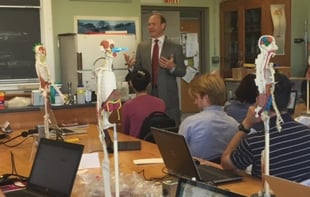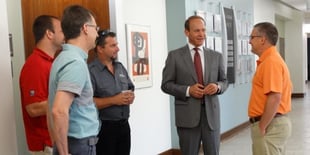Teachers from all different points in their careers are completing Project Lead The Way (PLTW) Core Training this summer. While some are new to the profession, some are shifting from years of traditionally disseminating information to leading students in their learning. PLTW’s President and Chief Executive Officer Dr. Vince Bertram visited teachers who trained at Embry-Riddle Aeronautical University; California Polytechnic University, Pomona; and Seattle University.
Embry-Riddle Aeronautical University
Since starting to teach PLTW five years ago, Frank Walsh has seen a tremendous transformation in his school, Avalon Middle School in Orange County Public Schools in Florida. He has completed Core Trainings for and taught Design and Modeling, Automation and Robotics, Flight and Space, Green Architecture, and Medical Detectives, due in part to the increasing student demand for the PLTW experience.
“When I first started teaching PLTW, I was doing all of the courses by myself,” he said. “The school had to start a waiting list because of the popularity of the classes.”
The business technology teacher in the school saw what Walsh was doing and joined.
“With the two of us, the PLTW program became even better,” he said. “We could teach best practices, and we grew a lot.”
Demand continued to grow, so the school added another teacher. Now, each grade level has a PLTW teacher, and PLTW participation has tripled.
Walsh taught for 22 years before starting PLTW, and describes his experience as a fresh start.
“I kind of taught my own thing for a long time,” he said. “My whole teaching life has changed with PLTW, and I am really excited to teach each year to see what new things I get to try.”
California Polytechnic University, Pomona
Carmen Garvis has taught PLTW for three years at Sanger High School in Sanger Unified School District in California and sees more than just program growth in her school; she sees the experience breaking down demographic barriers. Since the school introduced PLTW in 2014, participation has grown from 24 to approximately 150 students, and the school now offers the full PLTW Engineering pathway.
“[PLTW] has attracted a very diverse group of students,” she said. “[The] demographics have shifted to include more females and minorities. Without this program, these students may not have had the opportunity to explore STEM career choices. I have received numerous emails and phone calls thanking me for providing this opportunity for their child.”
One of Garvis’ students was accepted into the US Naval Academy STEM summer camp and another obtained an internship with PG&E.
“PLTW has had an enormous impact on our students,” she said. “This program not only helps them prepare for college, but more importantly, this gives them a real-world exposure. This is a critical step in helping our students determine their career path. “
Seattle University
Dale Nance has been teaching for 15 years but is in just his second year teaching PLTW at Tenaya Middle School in Fresno, California. Over two summers, Nance completed Core Training for Design and Modeling, Medical Detectives, Automation and Robotics, Science of Technology, Green Architecture, and Flight and Space, and he is on track to complete Magic of Electrons and Energy and the Environment. He also hopes to add Introduction to Computer Science.
“I can tell you I am really excited for my upcoming year,” he said. “My students are excited to come to my classroom and rarely want to miss a day.”
Nance sees his students excited about learning and eager to tackle the problems posed to them in PLTW.
“One of the ways the students explain our class is that the curriculum is hard, but easy, but complicated,” he said. “In their words, it’s hard because they really have to use their brain, but it’s easy because the steps are there for them to complete the complicated tasks, but it’s also complicated because there are a lot of steps and variables that need to be taken into consideration when problem solving.”
Although his students experience setbacks during the problem-solving process, Nance sees them persisting through failures.
“It really is fun to see students show frustration for solving a problem, but are always feeling confident they can come up with a solution,” he said. “PLTW does a great job of challenging students to think on a higher level without pushing them to the point where they shut down.”
Nance is familiar with being vulnerable in a classroom setting and persisting through challenges. After experiencing Core Training so many times, he has advice for teachers who may feel uncomfortable being positioned as the student.
“My advice for first timers is never feel that you are alone, because you are absolutely not,” he said. “You are going to have anxiety teaching and training in the beginning, and that’s perfectly normal, but I can promise you that your Master Teachers are there to help you succeed both during and after your training. I understand at times it can feel overwhelming, but new and exciting things always have a tendency to feel that way, and we end up looking back on them and laughing.”
Stay tuned for more stories from On the Road, where Vince travels to Bucknell University and Lawrence Tech University.
Stay current on Vince’s travels – and the latest in education and workforce development news – by following him on Twitter at @VinceBertram.


